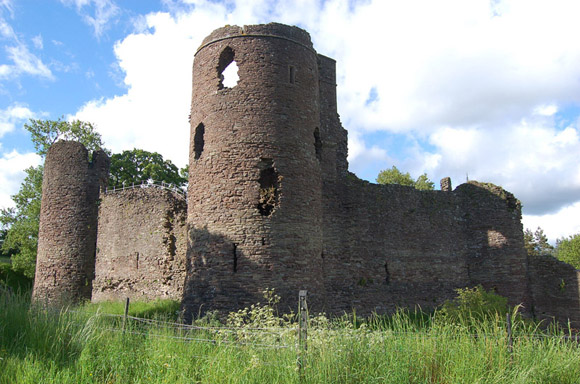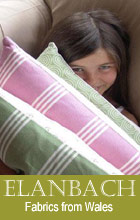Grosmont Castle is a remarkably well-preserved three phase fortress. It was quite possibly founded by William FitzOsbern, 1st Earl of Hereford during his invasion of South Wales in 1070. Earl William was killed the next year and his son Roger was stripped of his lands in 1075. The land on which Grosmont castle was built now passed either under the control of the Ballon family of Abergavenny or the Lacys of Weobley and Longtown. The powerful Marcher baron Pain Fitz John acquired Grosmont in the reign of King Henry I of England (1100-35) and converted it into the head of a lordship which stretched from White Castle in the west to Orcop castle in the east.
History
During the early twelfth century the castle was the centre or caput of what was known as the honour of Grosmont. The great hall was one of the first features constructed of the castle and this was used as the civil capital of the lordship. Certainly this hall was not the work of Hubert de Burgh, 1st Earl of Kent in the early thirteenth century as is often claimed. Just compare the one surviving door jamb of the hall to those of Hubert Burgh's work which can also be seen within his fortresses at Skenfrith Castle and White Castle. One is typically �twelfth' century, the others �thirteenth'.
The early hall at Grosmont was most probably built within forty years either side of 1110. It still stands two stories high and has many features of comfort within its walls. There are many reasons to believe that this hall was built early in the castle's history for the evidence points clearly to Grosmont castle having been fortified in stone from the first. Who actually first built the castle though, is more of a problem.
Both the first earls of Hereford and Pain Fitz John had a great deal of wealth and ruled the Kingdom of Gwent at a time when the stable rule of the Normans in Wales seemed inevitable. Grosmont hall is certainly not a fortress. It was built as the administrative centre of a barony with both comfort and administration in mind. White Castle to the west, however, was built as a fortress from the first, probably in concert with the foundation of Grosmont. Orcop castle to the east, a true motte and bailey fortress, may be older.
In 1134 rebellion broke out in Wales and in July 1137 Pain Fitz John was killed in action fighting against the Welsh. Immediately before his death Pain granted all his honour of Grosmont to King Stephen in exchange for the province of Archenfield. With the Angevin rebellion of 1139 Brian Fitz Count of Abergavenny took Grosmont castle from the king and in 1142 granted it by charter to Walter Hereford. This is our first certain historical mention of the fortress. Walter was killed around 1160 fighting in the Holy Land. At this point King Henry II (1154-89) reclaimed the castle and placed royal soldiers within its walls. The castle, requiring little maintenance, remained a royal fortress for the next forty years. In 1201 it was granted to Hubert Burgh �for his maintenance' in the wars of the period. In 1205 he was wounded almost to death in the Loire valley and the castle passed for a few years to the Braose family while Hubert recovered his health.
After the death of King John in 1216 Hubert regained his castles in the Welsh Marches in 1219. It was Hubert who was responsible for turning the administrative castle of Grosmont into a fortress. Royal records from when Hubert was running the government of England, show that he was undertaking building work at Grosmont between 1224 and 1226. His work gave the castle much of its appearance today. His buildings included the gatehouse, which has mostly disappeared in the last 100 years, and the three D-shaped towers in the castle's enceinte. In 1233 the castle witnessed the rout of King Henry III's army by rebel English and Welsh forces, who included in their midst Earl Hubert Burgh himself! In the aftermath of this victory Hubert was granted back Grosmont castle and he held it until his final fall from grace in 1239.
In 1267 King Henry III granted the castle to his second son Prince Edmund and this man undertook the conversion of the fortress of Earl Hubert Burgh into one of his main residences. He demolished one of Hubert Burgh's D-shaped towers and built accommodation over it and raised the height and extended the south-west tower to make it into a five-storeyed great tower or keep. The living quarters of this massive tower could only be approached via a wooden stairway to the north. To the east was a giant false doorway which only allowed access to the ground and first floors. The steps currently seen rising up to the castle wall walk from this doorway is the work of twentieth century restorers who are also responsible for the creation of much of the double doorway into the early hall.
Most of Prince Edmund's rebuilding at Grosmont was carried out probably in the period 1274 to 1294. Part of this reconstruction included the building of the great chimney of which Grosmont is justifiably famous. Before leaving the village of Grosmont be sure to visit the church, the nave of which is built in the same style as the early great hall of the castle. The tower and other parts of the church fabric were built by Prince Edmund for his mother, Queen Eleanor, the wife of Henry III. Within its walls are the much eroded remains of an effigy of a knight, probably of the thirteenth century. There is now no evidence as to this knight's identity, but perhaps he was the engineer Ralph Grosmont, so strongly entwined with the history of all three royal castles of Skenfrith, Grosmont and White Castle. |











